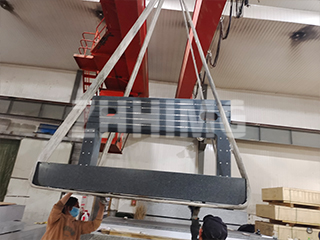Granite surface plates, also known as marble surface plates, are essential tools used for measuring the straightness and flatness of workpieces, as well as for the installation and alignment of equipment. These plates are commonly employed to inspect machine tool tables, guide rails, and the flatness and straightness of precision components.
Before using a granite surface plate, it is crucial to understand its structural features and properties to ensure accurate measurements and efficient use. The straightness of the measuring surface is the key precision indicator for surface plates. The tolerance of the straightness measurement defines the accuracy level of the surface plate, and selecting the right plate based on its accuracy class ensures consistency in manufacturing precision and measurement standards.
Key Features of Granite Surface Plates:
-
Material Structure and Durability:
-
Granite used for surface plates has a dense crystal structure with a smooth surface that is resistant to abrasion and has low roughness.
-
It is acid-resistant, alkali-resistant, corrosion-resistant, and non-magnetic, making it highly durable and suitable for a variety of industrial applications.
-
-
Stability and Precision:
-
The granite surface plate is made from a material that undergoes long-term aging, which reduces internal stresses and ensures material stability, preventing deformation.
-
It has a low coefficient of thermal expansion, meaning temperature changes have minimal impact on the precision of measurements.
-
Unlike metal materials, granite does not rust, and it is not affected by moisture, making it easy to maintain and more reliable over time.
-
-
Resilience and Performance:
-
When the work surface is damaged, it will only develop small depressions without affecting the measurement accuracy, ensuring continued high precision over the plate’s lifespan.
-
Granite’s hardness and rigidity allow it to maintain precision even after repeated use.
-
-
Easy Maintenance:
-
The surface plate requires minimal maintenance, as it is resistant to dirt and debris. It does not need to be coated with oil and is easy to clean.
-
Regular care can significantly extend the surface plate’s service life and maintain its high-performance level.
-
Advantages of Granite Surface Plates:
-
High Precision and Stability:
-
Granite undergoes natural aging, resulting in a uniform structure and minimal thermal expansion, ensuring high accuracy and maintaining precision over time.
-
It has excellent rigidity and hardness, making it ideal for precision measurements.
-
-
Durability and Low Maintenance:
-
Granite surface plates are highly resistant to acids, alkalis, and corrosion. They do not rust, and they require little to no oil or coating, simplifying maintenance and improving durability.
-
The plates are also dust-resistant, preventing debris from sticking to the surface, which helps maintain their accuracy.
-
-
Consistent Measurement Accuracy:
-
Unlike metal or other materials, granite surface plates will not change shape over time, ensuring consistent measurement accuracy even under normal environmental conditions.
-
The plate remains stable and precise at ambient temperatures, without requiring special temperature conditions for measurement.
-
-
Non-Magnetic and Smooth Movement:
-
Granite is non-magnetic, ensuring that no external magnetic fields will interfere with the measurements. The surface plate allows for smooth movement during use, without any dragging or friction.
-
Why Choose Granite Surface Plates for Your Operations?
-
Unmatched Durability: Granite surface plates are built to withstand wear and tear while maintaining high precision.
-
Accurate Measurements: Ideal for use in precision machining and quality control environments.
-
Low Maintenance: Simple to maintain with no need for oiling or special storage conditions.
-
Long Lifespan: High-quality granite ensures that the surface plate lasts for many years, even in high-demand industrial settings.
Granite surface plates are essential tools for precision measurements in various industrial applications. By understanding the properties and features of these surface plates, you can ensure that you’re using the most reliable and accurate measuring tools available, improving both manufacturing processes and measurement precision.
Post time: Aug-08-2025

